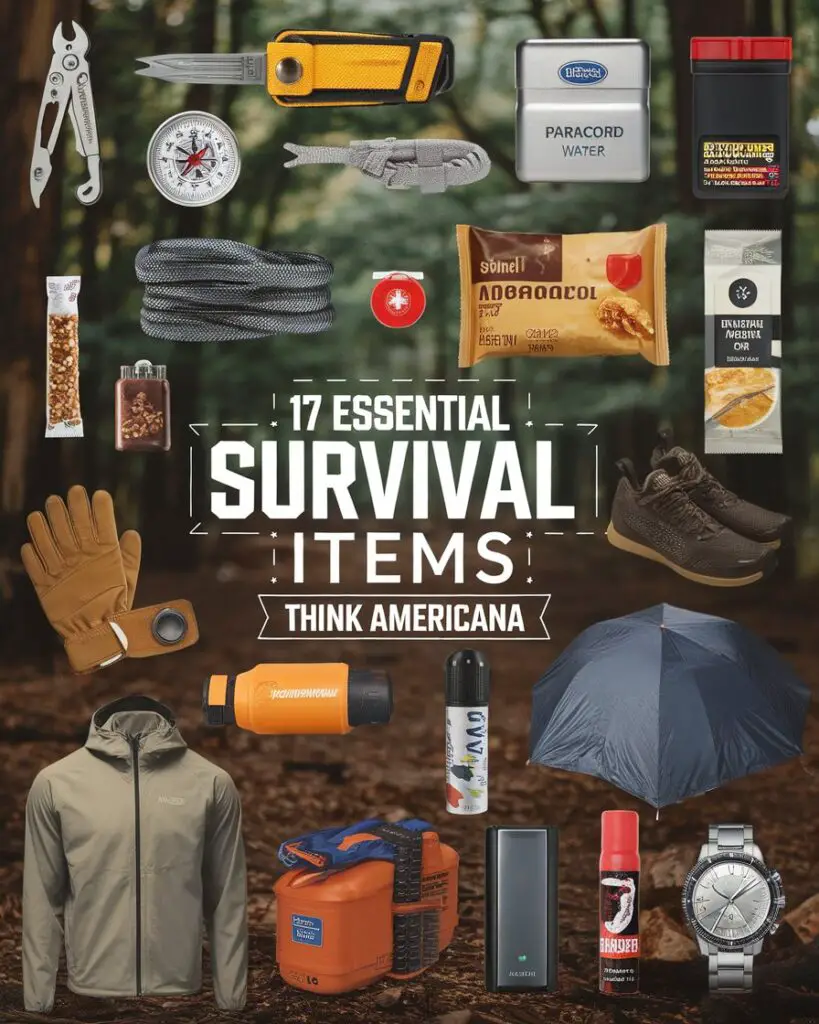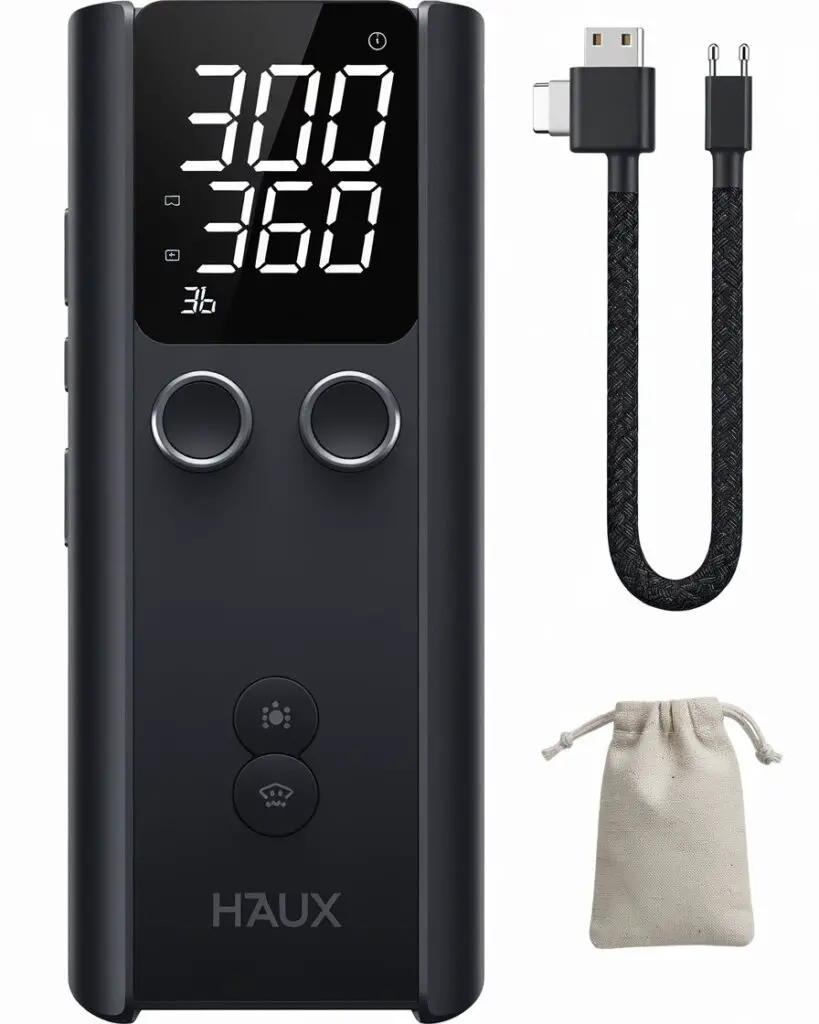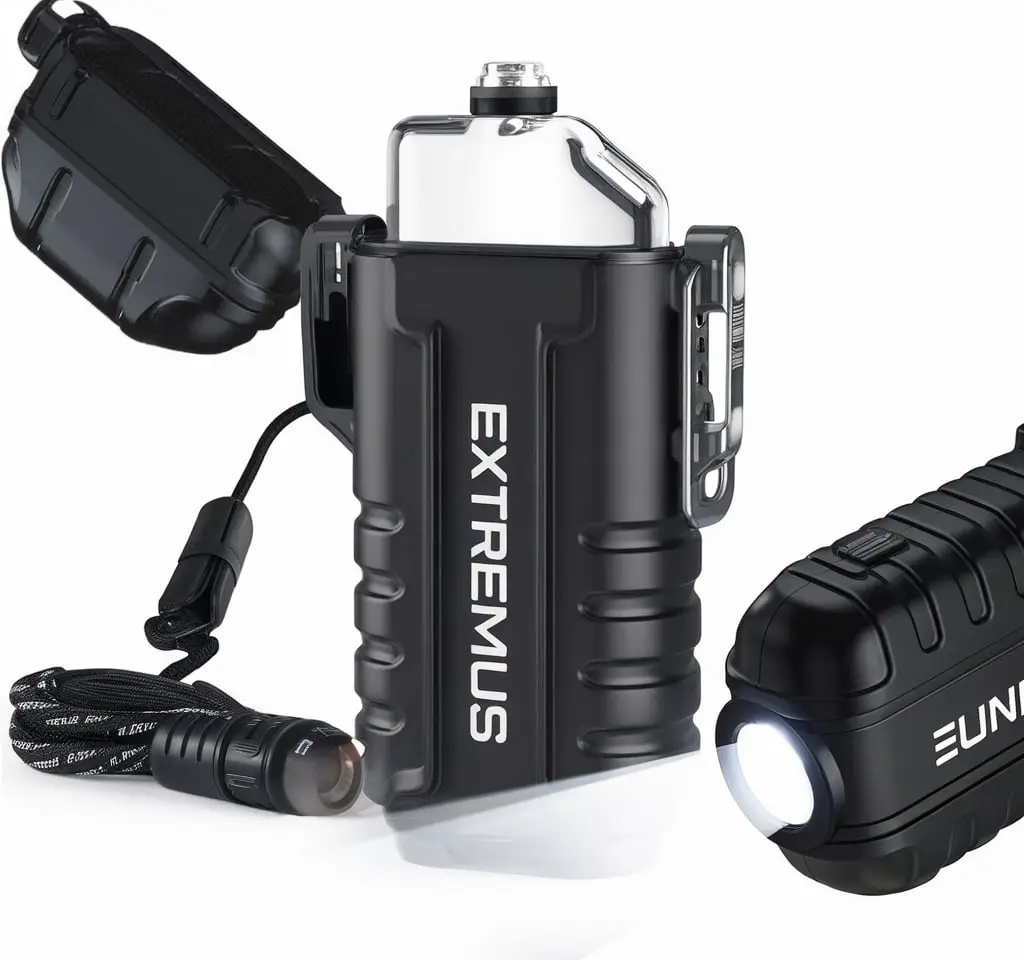I've realized that preparing for emergency situations is essential. That's why I decided to explore the world of survival items and gear.
What are the top 17 survival items that can help you stay safe and self-reliant in challenging situations?

Table of Contents
Disclaimer: There are affiliate links in this article. That means if you use them to make a purchase, I get pad a commission at no extra charge to you. It's how we keep the lights on.
There are countless options and must-have items out there. In this article, I'll share insights on essential survival tools that you might consider including in your kit.
Let's dive into the essentials that'll boost our preparedness for any unexpected situation.
1) Pocket Tool or Multitool

When I head out into the great outdoors, my trusty pocket tool or multitool is always by my side. It's like having a tiny toolbox right in my pocket.
With a range of features, these tools are perfect for any survival situation.
From cutting to screwing, there's a tool for every need. Most multitools come with a knife, screwdriver, pliers, and even a bottle opener.
It's amazing how something so compact can carry so much utility.
Durability matters a lot to me, especially when I’m hiking and camping. A stainless-steel multitool can handle tough conditions without rusting or breaking. It's something I rely on for quick fixes and unexpected tasks while out and about.
Our Recommendation: Gerber 15-in-1 Multi Tool with Pocket Knife
2) Compass

When I think of essential survival tools, a reliable compass definitely makes the list.
Whether I’m trekking through dense forests or navigating unfamiliar terrain, a compass is indispensable. It ensures I can always find my way, even when technology fails.
The beauty of a compass lies in its simplicity. It’s lightweight, requires no batteries, and works virtually anywhere on Earth.
I find comfort in knowing that it always points towards magnetic north, guiding me in the right direction.
Choosing the right compass involves understanding a few key features.
I prefer a model with a global needle and adjustable declination, as these features enhance accuracy.
Many people, including myself, enjoy the reliability and precision found in popular brands like Suunto and Silva.
Our Recommendation: Eyeskey Multifunctional Tactical Survival Military Compass with Lanyard & Pouch
3) Battery/Air Compressor

In my car survival kit, a battery-powered air compressor is a must-have. It's super handy for quickly inflating tires when I'm stuck on the road. This little device can save me from a flat tire disaster.
I recommend a compact, lightweight model that’s easy to store in the trunk.
One good option is the Ryobi One+ 18V Cordless Portable Air Compressor. It’s both portable and efficient.
I always check the maximum pressure rating to ensure it meets my needs.
The Milwaukee M18 Fuel is another great choice for compactness and reliability. With a good air compressor, I'm prepared for any tire troubles.
Our Recommendation: Tire Inflator Portable Air Compressor
4) Lighter

When I pack my survival kit, a lighter is one of the first things I put in. Having an easy way to start a fire can make a huge difference out in the wilderness.
I prefer a lighter that’s windproof and waterproof.
Models like the Black Beard Arc Survival Lighter are ideal because they hold up against challenging conditions.
Since lighters can run out of fuel, it’s smart to choose a rechargeable one or carry a backup like the Exotac FireSLEEVE for extended trips.
The Urgrette Torch Lighter has a triple jet flame, which makes it easier to start fires quickly. It’s reliable when I’m camping or dealing with emergency situations.
A lighter shouldn’t just work in fair weather. I need something tough since conditions can change quickly outdoors. A good lighter is vital equipment for survival.
Our Recommendation: Extremus Blaze 360 Rechargeable Electric Lighter
5) Small First Aid Kit

When I'm preparing for a survival situation, packing a small first aid kit is always a priority. It's compact yet vital for handling emergencies.
Having essentials like bandages, antiseptic wipes, and basic medications can make all the difference.
In my small first aid kit, I include adhesive bandages in various sizes to cover cuts and scrapes.
I also pack a pair of tweezers for removing splinters or ticks.
It's important to have antiseptic wipes to clean wounds and prevent infections.
I remember to add items like an elastic bandage for stabilizing sprains and some gauze pads for larger injuries.
Carrying a pair of small scissors is handy for cutting gauze or tape.
I also like to include basic medications such as pain relievers and antihistamines.
Keeping it lightweight and focused on essentials allows me to act quickly in any situation. My kit is stored in a sturdy, waterproof case to protect the contents. Being prepared with a small first aid kit gives me peace of mind on any adventure.
Our Recommendation: General Medi Mini First Aid Kit
6) Paracord

Paracord is one of my favorite survival items because of its versatility and strength. Originally used in parachute cords, its lightweight nylon material is incredibly strong.
When I'm out in the wild, having paracord means I have multiple uses in one compact tool.
I often use paracord to create makeshift shelters, secure gear, or even for a quick fix to broken equipment. It's especially useful for setting traps in survival situations.
Having a good length of paracord in my backpack always adds a layer of preparedness to any adventure.
There's a bunch of fun projects you can make with paracord too, like a monkey fist or a lanyard.
These projects aren’t just crafty endeavours; they transform the cord into practical tools.
Sometimes, I enjoy making a paracord bracelet, which becomes an easy-to-access cord supply when needed.
Our Recommendation: 1000Ib Paracord Rope
7) Water

When it comes to survival, water is essential. I always remind myself to prioritize having a reliable water source. In emergency situations, access to clean drinking water is crucial.
I typically start with a couple of bottles of water in my kit. It's a basic step, but ensuring sufficient hydration can significantly impact my well-being during unforeseen circumstances.
In addition to bottled water, I consider other methods for obtaining clean water.
A portable water filter or purification tablets can be lifesavers. These tools give me options if my initial supply runs low and help ensure I'm ready to handle different situations confidently.
Carrying a lightweight and compact water purifying system is also something I think about. It hardly takes up any space, making it easy to include in my survival gear.
While planning for an emergency, I like knowing I'm prepared for whatever challenges might come my way.
We're not going to make any recommendation of water. Just make sure to have two 32 ounces or more of water.
8) Granola Bar
I always include a granola bar in my everyday carry. It's such a simple but effective way to ensure I have a quick source of energy when I need it.
Just think about those hectic days when you skip breakfast or lunch unintentionally.
Granola bars are portable and can easily fit into any bag. They’re non-perishable and offer a decent shelf life, so I don't have to replace them too often.
There’s a wide variety to choose from, catering to different dietary preferences, whether you're vegan, gluten-free, or on a high-protein diet.
For me, the best part is the variety of flavors available. From chocolatey treats to nutty options, there’s always something that satisfies my taste buds.
Plus, I think having a granola bar on hand helps avoid unhealthy snack choices when I’m feeling peckish.
Our Recommendation: SOS Food Granola Bars - 5 Year Shelf Life
9) Survival or Tactical Pen
When I think about a survival pen, versatility comes to mind. These pens are not just for writing; they often feature tools like glass breakers or flashlights. They're a handy addition to any survival kit.
I’ve found that a good survival pen can be a lifesaver in unexpected situations.
Imagine needing to break a car window or defend yourself. A strong, durable survival pen comes to the rescue.
Writing with one is reliable even in tough conditions, thanks to features like pressurized ink cartridges. It ensures you can jot down notes or mark your trail, no matter the environment.
Incorporating a survival pen into my everyday carry gives me peace of mind. Knowing I've tools readily available for emergencies adds confidence in my daily adventures.
Our Recommendation: 12-in-1 Tactical Pen Multitool
10) Gloves

When it comes to survival, gloves are incredibly important. I can't imagine facing rough conditions without a reliable pair.
They shield my hands from cuts, scrapes, and extreme weather. A sturdy pair of gloves gives me the confidence to handle just about anything.
The options out there for gloves can be overwhelming, but I lean towards ones offering good dexterity.
I’ve found that tactical gloves, like the Mechanix Wear Tactical Work Gloves, are a solid pick. They combine protection with flexibility, making them ideal for various tasks.
In cold weather, I reach for insulated gloves to keep my fingers warm. Meanwhile, waterproof gloves keep my hands dry during rainy adventures.
I also like knowing that if a situation calls for it, my gloves have me covered against unexpected hazards.
Our Recommendation: Mechanix Wear Tactical Gloves
11) Headlamp

When I think about essential survival gear, a reliable headlamp tops my list. It's the kind of gear that makes a world of difference when I’m navigating trails in dim light or handling camp chores at night. A good headlamp offers hands-free convenience and ensures that I stay focused on the path ahead.
In my experience, choosing the right headlamp involves balancing weight, brightness, and battery life.
Lightweight models, like those weighing under 2 ounces, are ideal for long treks.
I look for options with adjustable brightness settings, enabling me to conserve battery and get the light I need.
Waterproof headlamps are equally beneficial, especially in unpredictable weather.
Features like rechargeable batteries or backup disposable ones add to their reliability.
The Olight Perun series and Fenix models are well-regarded for their performance, offering durable cases and excellent light output.
Headlamps with a good beam distance can make all the difference.
Whether it's spotting uneven ground or locating my tent from a distance, having a powerful beam is invaluable.
I've found that brands like Black Diamond and Petzl consistently deliver on quality and innovation.
Our Recommendation: LHKNL Headlamp Flashlight
12) Light Jacket

When packing my survival kit, a light jacket is something I never forget. Its versatility makes it essential for different weather conditions.
A light jacket offers protection from wind and provides a layer of warmth during chilly nights.
It’s easy to pack and doesn’t add much weight to my gear.
I prefer jackets with water-resistant features, which keeps me dry during unexpected rain.
Many designs come with compact pockets, making it convenient to store small items.
Breathable fabrics are a must for comfort when I'm on the move.
This helps regulate body temperature and prevents overheating during physical activities.
For me, a light jacket is not just about functionality but comfort too. It’s crucial in bridging the gap between practicality and accessibility.
We aren't going to make any recommendations. Just grab an old jacket that will keep you warm in an emergency.
13) Pepper Spray

Pepper spray is a must-have in my survival kit. It provides a reliable means of self-defense against potential threats. Except in legal restrictions, it’s portable and easy to use.
I love that modern options, like the FOX Labs 5.3 and Sabre 3-in-1, offer effective protection.
They have high Scoville Heat Units, making these sprays potent deterrents against attackers and animals.
These sprays can reach up to 20 feet, keeping me at a safe distance while defending myself.
It's reassuring knowing I have a non-lethal way to protect myself in emergencies.
Our Recommendation: POM Pepper Spray
14) Rain Poncho

When I pack for a survival adventure, a rain poncho is always on my list. It's a versatile item, providing essential protection against unexpected downpours. Not only does it keep me dry, but it also serves as a quick shelter when needed.
I appreciate that many rain ponchos can transform into a temporary tarp or shelter.
The snaps and grommets on military-spec ponchos make it simple to string them up between trees. This adaptability is crucial during sudden weather changes.
The rain poncho isn't just for rain. In a pinch, I've used mine to create makeshift ground covers or windbreaks.
Its compact size and lightweight design ensure it fits easily into my backpack. This makes it an unobtrusive yet vital part of my gear collection.
Our Recommendation: Hagon PRO Disposable Rain Ponchos for Adults (5 Pack)
15) Battery Pack for Charging Electronic Devices

I always carry a reliable battery pack when heading out into the wilderness. Today's technology helps keep me connected and capture memories.
A good battery pack should offer a high capacity, as I might be away from outlets for days.
Popular models often range from 10,000 mAh to as much as 137,700 mAh.
I look for features like fast charging and multiple output ports. This ensures all my gadgets like phones, cameras, or GPS devices stay powered up.
Durability is crucial.
Many outdoor battery packs come with rugged designs and waterproof features, which gives me peace of mind in harsh conditions.
Some battery packs even support solar charging, which can be a lifesaver if power sources are limited.
A solar-compatible option is helpful on extended hikes.
Our Recommendation: VEEKTOMX Mini Power Bank 10000mAh
16) Knife

When packing my survival kit, a knife is always one of the first items I include. Whether I'm out camping, hiking, or dealing with unexpected situations, a knife is incredibly versatile.
I prefer a good-quality survival knife, particularly one that's durable and easy to handle.
It's essential for various tasks, from cooking to setting up shelter. Knives with a sturdy handle and a sharp, reliable blade work best for me.
I appreciate multi-tool knives since they often come with additional features like screwdrivers or bottle openers.
These extras can really come in handy when I'm out in the wild and need a quick fix.
Our Recommendation: Serrated Blade Pocket Knife
17) Watch
In a survival situation, having a reliable watch can be crucial. It helps me keep track of time and manage my resources more effectively. Knowing the time can be important for tasks like rationing food, managing sleep, or simply staying grounded.
I often wear a durable survival watch like the Casio G-Shock or Garmin Instinct. These watches are built to withstand challenging conditions while offering features beyond just telling time. They're tough and can resist water, shocks, and extreme temperatures.
Some models have additional survival features, such as GPS, altimeters, or solar charging, making them handy in various environments.
I appreciate when my watch provides critical information during outdoor adventures or emergencies. Having the right watch equipped for multiple scenarios gives me peace of mind.
Odds are you are already wearing a watch. Just make sure to have one that is durable with long battery life, such as the ones mentioned, Casio G-Shock or Garmin Instinct.
Basic Survival Skills

Understanding how to find shelter and start a fire are crucial survival skills. These skills can help protect against the elements and improve chances of staying safe and warm.
Finding Shelter
When I'm out in the wild, finding shelter is my top priority.
Natural features like caves or overhangs can provide quick refuge. If those aren't available, I use materials like branches, leaves, and tarps to build a simple lean-to or debris hut.
The key is a solid roof and walls to keep out rain and wind. I also make sure to choose a site that is safe from potential hazards like falling branches or flooding.
Insulation from the ground is also essential to protect against cold. I line the floor with leaves or pine needles, which helps retain body heat.
Starting a Fire
Starting a fire is both an art and a science.
I usually carry waterproof matches or a lighter, but I also know how to create sparks using a flint and steel.
To get a fire going, I gather tinder like dry grass, leaves, or paper if I have any.
Stacking small twigs in a teepee shape helps flames catch and grow.
Maintaining a fire from kindling to larger logs requires attention and practice.
To stay safe, I always keep a safe distance from the fire and ensure it's fully extinguished before leaving my camp.
Survival Mindset

When I think about survival, the gear is important, but my mindset is the most crucial tool. A solid survival mindset helps me navigate unpredictable situations with calmness.
Key Aspects of a Survival Mindset:
Adaptability: I need to be flexible and ready to adjust my plans quickly.
Patience: Staying calm and giving myself time is essential.
Self-awareness: I need to know my strengths and limitations.
In any challenging scenario, remaining calm is crucial. Panic can lead to mistakes. Training my mind to stay composed increases my chances of making wise decisions.
Adopting a positive attitude can make a big difference. It's not just about thinking "I can do this," but truly believing it. This mindset boosts my confidence in tough times.
I also strive to practice emotional regulation. When fear arises, managing it instead of letting it take control helps me stay focused on my tasks.
Survival isn't just about physical preparedness. It's about mental readiness too. By continually working on my mindset, I put myself in a better position to handle the unexpected.
